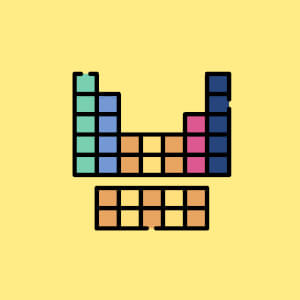


The periodic table of elements, or periodic table for short, is a way of displaying and organizing all the known chemical elements. Each element is listed in order according to its atomic number, which is a measure of the number of protons found in the nucleus of an atoms of that element.
The table is further organized into vertical columns, called groups, and horizontal rows, called periods. The power of the periodic table lies in using this organization to make predictions about and comparisons between the different elements.
What do the letters like "H", "Li", and "Au" on the periodic table stand for? These are known as chemical symbols, kind of like abbreviations or shorter versions of each element. Some are easier to remember and understand, like "H" for hydrogen, and "Li" for lithium. Others use words from other languages, such as "Au" for gold, which is aurum in Latin.
Groups are the 18 vertical columns of the periodic table. Elements in a group share the same amount of valence electrons, the electrons in an atom that participate in chemical reactions. Because of this, elements within a group share similar chemical properties and reactivity with one another. This is what makes the periodic table such a useful tool for scientists.
The groups are organized into metals, metalloids (elements that share some characteristics of metals), and nonmetals. Some important groups have special names, like groups 17 and 18, for example. Group 17, the "halogens", includes highly reactive elements like chlorine, fluorine, and iodine. Group 18, the "noble gases", includes non-reactive gases like helium and neon.
The periods are the 7 horizontal rows of the periodic table. They help us organize elements based on their electron shells or orbitals, which are the areas where electrons move around in atoms. Elements in the same period have a similar number of these shells.
Even though elements in a period share some traits, they are not as similar as elements in the same group. Moving from left to right in a period, each element becomes slightly "less metallic" than the one before it. This means they have fewer metallic properties. Additionally, each element in a period has one more proton in its nucleus, which is the central part of an atom.
When Mendeleev created what eventually became the Periodic Table, he left gaps where he predicted new elements should exist, based on the other elements in the table and their properties. His predictions later helped to guide the discovery of many unknown elements, which were then added to the table. In addition, scientists later used Mendeleev's insights to develop techniques for creating new elements through nuclear reactions, which led to the discovery of many of the lab-created elements we know today.
Out of the 118 known elements in the periodic table, only 94 have been found naturally on Earth. The other 24—including the four newly-discovered elements nihonium, moscovium, tennessine, and oganesson—were created in labs by bombarding atoms with additional protons!
The only letter that doesn't appear on the periodic table is the letter 'J.' This is likely because most of the elements' names are based off of words in old Latin or Greek, both languages whose alphabets lack the letter.